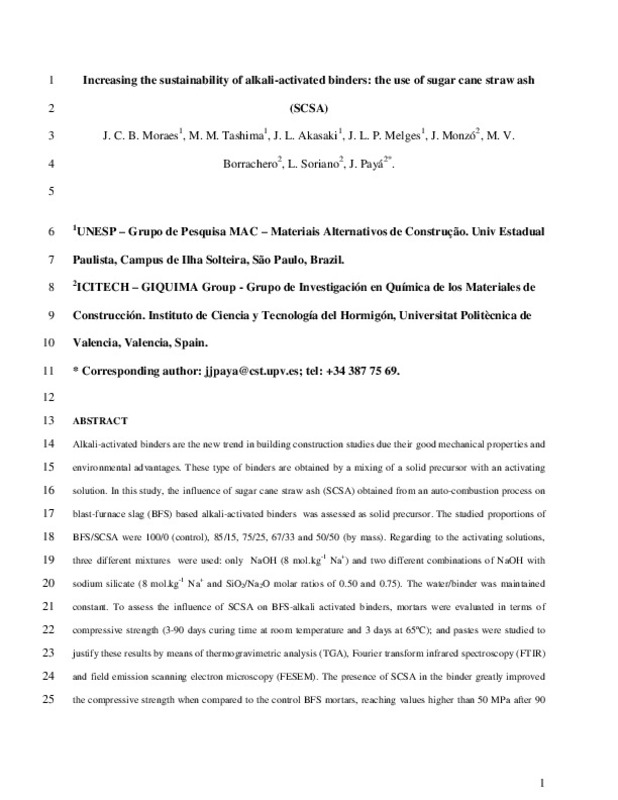Moraes, J.; Mitsuuchi Tashima, M.; Akasaki, JL.; Pinheiro Melges, JL.; Monzó Balbuena, JM.; Borrachero Rosado, MV.; Soriano Martínez, L.... (2016). Increasing the sustainability of alkali-activated binders: The use of sugar cane straw ash (SCSA). Construction and Building Materials. 124:148-154. https://doi.org/10.1016/j.conbuildmat.2016.07.090
Por favor, use este identificador para citar o enlazar este ítem: http://hdl.handle.net/10251/82037
|
Título:
|
Increasing the sustainability of alkali-activated binders: The use of sugar cane straw ash (SCSA)
|
|
Autor:
|
Moraes, J.C.B

 Mitsuuchi Tashima, Mauro
Akasaki, Jorge Luis
Pinheiro Melges, Jose Luis
Mitsuuchi Tashima, Mauro
Akasaki, Jorge Luis
Pinheiro Melges, Jose Luis

 Monzó Balbuena, José Mª
Monzó Balbuena, José Mª

 Borrachero Rosado, María Victoria
Borrachero Rosado, María Victoria

 Soriano Martínez, Lourdes
Soriano Martínez, Lourdes

 Paya Bernabeu, Jorge Juan
Paya Bernabeu, Jorge Juan
|
|
Entidad UPV:
|
Universitat Politècnica de València. Escuela Técnica Superior de Ingenieros de Caminos, Canales y Puertos - Escola Tècnica Superior d'Enginyers de Camins, Canals i Ports
Universitat Politècnica de València. Instituto de Ciencia y Tecnología del Hormigón - Institut de Ciència i Tecnologia del Formigó
|
|
Fecha difusión:
|
|
|
Resumen:
|
Alkali-activated binders are the new trend in building construction studies due their good mechanical properties and environmental advantages. These type of binders are obtained by a mixing of a solid precursor with an ...[+]
Alkali-activated binders are the new trend in building construction studies due their good mechanical properties and environmental advantages. These type of binders are obtained by a mixing of a solid precursor with an activating solution. In this study, the influence of sugar cane straw ash (SCSA) obtained from an auto-combustion process on blast-furnace slag (BFS) based alkali-activated binders was assessed as solid precursor. The studied proportions of BFS/SCSA were 100/0 (control), 85/15, 75/25, 67/33 and
50/50 (by mass). Regarding to the activating solutions, three different mixtures were used: only NaOH (8 mol kg1 Na+ ) and two different combinations of NaOH with sodium silicate (8 mol kg1 Na+ and SiO2/Na2O molar ratios of 0.50 and 0.75). The water/binder was maintained constant. To assess the influence of SCSA on BFS-alkali activated binders, mortars were evaluated in terms of compressive strength (3 90 days curing time at room temperature and 3 days at 65 C); and pastes were studied to justify these results by means of thermogravimetric analysis (TGA), Fourier transform infrared spectroscopy
(FTIR) and field emission scanning electron microscopy (FESEM). The presence of SCSA in the binder greatly improved the compressive strength when compared to the control BFS mortars, reaching values higher than 50 MPa after 90 days. SCSA/BFS samples activated with sodium hydroxide yielded similar compressive strength values to those obtained for BFS mortars activated with sodium silicate. In the new binders, the partial replacement of BFS, the total replacement of sodium silicate solution and a new way of valorizing sugar cane straw enhanced sustainability.
[-]
|
|
Palabras clave:
|
Silicates
,
Mechanical properties
,
Biomass
,
Renewable resources
,
Microstructural characterization
,
Electron Microscopy Service of the UPV
|
|
Derechos de uso:
|
Reserva de todos los derechos
|
|
Fuente:
|
Construction and Building Materials. (issn:
0950-0618
)
|
|
DOI:
|
10.1016/j.conbuildmat.2016.07.090
|
|
Editorial:
|
Elsevier
|
|
Versión del editor:
|
https://doi.org/10.1016/j.conbuildmat.2016.07.090
|
|
Código del Proyecto:
|
info:eu-repo/grantAgreement/MECD//PHB-2011-0016-PC/ES/Nuevos conglomerantes basados en la activación alcalina de cenizas de babazo y de hoja de caña de azúcar/
info:eu-repo/grantAgreement/CNPq//401724%2F2013-1/
|
|
Agradecimientos:
|
The authors would like to thanks to CNPq processo no. 401724/2013-1 and the "Ministerio de Education, Cultura y Deporte" of Spain ("Cooperacion Interuniversitaria" program with Brazil PHB-2011-0016-PC). Thanks are also ...[+]
The authors would like to thanks to CNPq processo no. 401724/2013-1 and the "Ministerio de Education, Cultura y Deporte" of Spain ("Cooperacion Interuniversitaria" program with Brazil PHB-2011-0016-PC). Thanks are also given to the Electron Microscopy Service of the Universitat Politecnica de Valencia.
[-]
|
|
Tipo:
|
Artículo
|






![[Cerrado]](/themes/UPV/images/candado.png)



